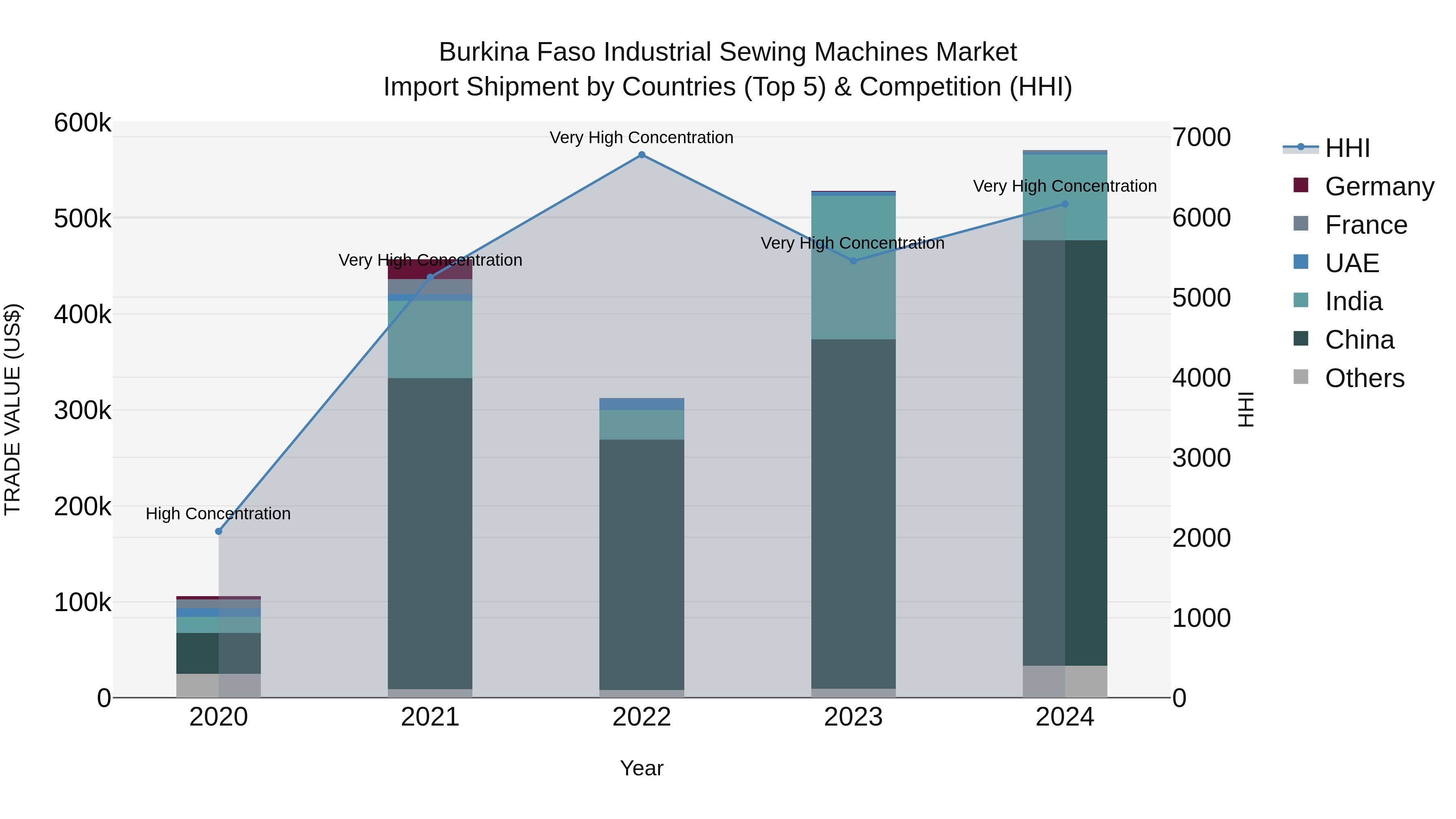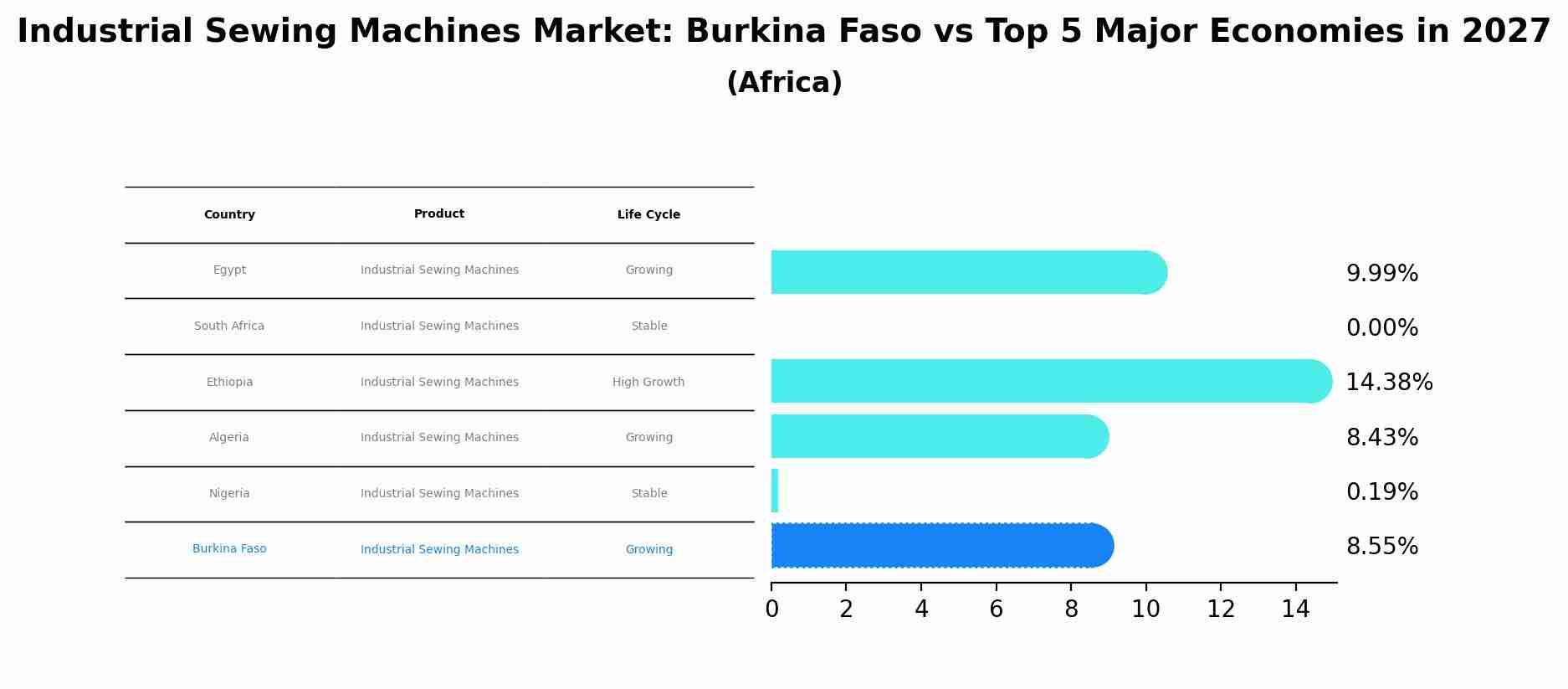Burkina Faso Industrial Sewing Machines Market (2025-2031) | Forecast, Size, Segmentation, Trends, Revenue, Companies, Growth, Value, Industry, Outlook, Analysis & Share
| Product Code: ETC4742792 | Publication Date: Nov 2023 | Updated Date: Oct 2025 | Product Type: Market Research Report | |
| Publisher: 6Wresearch | Author: Shubham Deep | No. of Pages: 60 | No. of Figures: 30 | No. of Tables: 5 |
Burkina Faso Industrial Sewing Machines Market Top 5 Importing Countries and Market Competition (HHI) Analysis
Burkina Faso continues to rely heavily on imports of industrial sewing machines, with top exporting countries in 2024 being China, India, Ghana, Indonesia, and Italy. The high Herfindahl-Hirschman Index (HHI) indicates a concentrated market. The impressive compound annual growth rate (CAGR) of 52.41% from 2020 to 2024 highlights the increasing demand for sewing machines in Burkina Faso. Additionally, the growth rate of 8.08% from 2023 to 2024 suggests a sustained upward trend in the market, showcasing opportunities for further expansion and investment in the sector.

Industrial Sewing Machines Market: Burkina Faso vs Top 5 Major Economies in 2027 (Africa)
Burkina Faso's Industrial Sewing Machines market is anticipated to experience a growing growth rate of 8.55% by 2027, reflecting trends observed in the largest economy Egypt, followed by South Africa, Ethiopia, Algeria and Nigeria.

Burkina Faso Industrial Sewing Machines Market Overview
The industrial sewing machines market in Burkina Faso is developing as the textile and apparel industries require advanced equipment for high-volume production. Industrial sewing machines are essential for producing garments, upholstery, and other textile products. The market is supported by the growth of the textile sector and the demand for efficient sewing solutions. Challenges include the high cost of machines and the need for technical support and maintenance.
Drivers of the market
The industrial sewing machines market in Burkina Faso is driven by the demand for efficient and high-quality sewing solutions in the textile and garment industries. Industrial sewing machines are used for mass production and require advanced features to ensure precision and productivity. The growth of the textile sector and the need for reliable sewing equipment are supporting market growth.
Challenges of the market
The industrial sewing machines market in Burkina Faso faces challenges such as high import costs and a lack of local manufacturing capabilities. Additionally, there is insufficient infrastructure for the distribution and maintenance of sewing machines, as well as a shortage of skilled technicians. Enhancing local production, improving distribution networks, and investing in technical support are crucial for overcoming these challenges and fostering growth in the industrial sewing machines market.
Government Policy of the market
The government supports the industrial sewing machines market by promoting the development and use of advanced sewing technologies. Policies may include funding for technology upgrades, support for local manufacturing, and regulations to ensure the efficiency and reliability of sewing machines.
Key Highlights of the Report:
- Burkina Faso Industrial Sewing Machines Market Outlook
- Market Size of Burkina Faso Industrial Sewing Machines Market, 2024
- Forecast of Burkina Faso Industrial Sewing Machines Market, 2031
- Historical Data and Forecast of Burkina Faso Industrial Sewing Machines Revenues & Volume for the Period 2021-2031
- Burkina Faso Industrial Sewing Machines Market Trend Evolution
- Burkina Faso Industrial Sewing Machines Market Drivers and Challenges
- Burkina Faso Industrial Sewing Machines Price Trends
- Burkina Faso Industrial Sewing Machines Porter`s Five Forces
- Burkina Faso Industrial Sewing Machines Industry Life Cycle
- Historical Data and Forecast of Burkina Faso Industrial Sewing Machines Market Revenues & Volume By Fabric Weight for the Period 2021-2031
- Historical Data and Forecast of Burkina Faso Industrial Sewing Machines Market Revenues & Volume By Lightweight for the Period 2021-2031
- Historical Data and Forecast of Burkina Faso Industrial Sewing Machines Market Revenues & Volume By Medium Weight for the Period 2021-2031
- Historical Data and Forecast of Burkina Faso Industrial Sewing Machines Market Revenues & Volume By Heavy Weight for the Period 2021-2031
- Historical Data and Forecast of Burkina Faso Industrial Sewing Machines Market Revenues & Volume By Extra-heavy Weight for the Period 2021-2031
- Historical Data and Forecast of Burkina Faso Industrial Sewing Machines Market Revenues & Volume By Bed Type for the Period 2021-2031
- Historical Data and Forecast of Burkina Faso Industrial Sewing Machines Market Revenues & Volume By Flat Bed for the Period 2021-2031
- Historical Data and Forecast of Burkina Faso Industrial Sewing Machines Market Revenues & Volume By Cylinder Bed for the Period 2021-2031
- Historical Data and Forecast of Burkina Faso Industrial Sewing Machines Market Revenues & Volume By Post Bed for the Period 2021-2031
- Historical Data and Forecast of Burkina Faso Industrial Sewing Machines Market Revenues & Volume By Application for the Period 2021-2031
- Historical Data and Forecast of Burkina Faso Industrial Sewing Machines Market Revenues & Volume By Apparel for the Period 2021-2031
- Historical Data and Forecast of Burkina Faso Industrial Sewing Machines Market Revenues & Volume By Non-apparel for the Period 2021-2031
- Burkina Faso Industrial Sewing Machines Import Export Trade Statistics
- Market Opportunity Assessment By Fabric Weight
- Market Opportunity Assessment By Bed Type
- Market Opportunity Assessment By Application
- Burkina Faso Industrial Sewing Machines Top Companies Market Share
- Burkina Faso Industrial Sewing Machines Competitive Benchmarking By Technical and Operational Parameters
- Burkina Faso Industrial Sewing Machines Company Profiles
- Burkina Faso Industrial Sewing Machines Key Strategic Recommendations
Frequently Asked Questions About the Market Study (FAQs):
1 Executive Summary |
2 Introduction |
2.1 Key Highlights of the Report |
2.2 Report Description |
2.3 Market Scope & Segmentation |
2.4 Research Methodology |
2.5 Assumptions |
3 Burkina Faso Industrial Sewing Machines Market Overview |
3.1 Burkina Faso Country Macro Economic Indicators |
3.2 Burkina Faso Industrial Sewing Machines Market Revenues & Volume, 2021 & 2031F |
3.3 Burkina Faso Industrial Sewing Machines Market - Industry Life Cycle |
3.4 Burkina Faso Industrial Sewing Machines Market - Porter's Five Forces |
3.5 Burkina Faso Industrial Sewing Machines Market Revenues & Volume Share, By Fabric Weight, 2021 & 2031F |
3.6 Burkina Faso Industrial Sewing Machines Market Revenues & Volume Share, By Bed Type, 2021 & 2031F |
3.7 Burkina Faso Industrial Sewing Machines Market Revenues & Volume Share, By Application, 2021 & 2031F |
4 Burkina Faso Industrial Sewing Machines Market Dynamics |
4.1 Impact Analysis |
4.2 Market Drivers |
4.3 Market Restraints |
5 Burkina Faso Industrial Sewing Machines Market Trends |
6 Burkina Faso Industrial Sewing Machines Market Segmentations |
6.1 Burkina Faso Industrial Sewing Machines Market, By Fabric Weight |
6.1.1 Overview and Analysis |
6.1.2 Burkina Faso Industrial Sewing Machines Market Revenues & Volume, By Lightweight, 2021-2031F |
6.1.3 Burkina Faso Industrial Sewing Machines Market Revenues & Volume, By Medium Weight, 2021-2031F |
6.1.4 Burkina Faso Industrial Sewing Machines Market Revenues & Volume, By Heavy Weight, 2021-2031F |
6.1.5 Burkina Faso Industrial Sewing Machines Market Revenues & Volume, By Extra-heavy Weight, 2021-2031F |
6.2 Burkina Faso Industrial Sewing Machines Market, By Bed Type |
6.2.1 Overview and Analysis |
6.2.2 Burkina Faso Industrial Sewing Machines Market Revenues & Volume, By Flat Bed, 2021-2031F |
6.2.3 Burkina Faso Industrial Sewing Machines Market Revenues & Volume, By Cylinder Bed, 2021-2031F |
6.2.4 Burkina Faso Industrial Sewing Machines Market Revenues & Volume, By Post Bed, 2021-2031F |
6.3 Burkina Faso Industrial Sewing Machines Market, By Application |
6.3.1 Overview and Analysis |
6.3.2 Burkina Faso Industrial Sewing Machines Market Revenues & Volume, By Apparel, 2021-2031F |
6.3.3 Burkina Faso Industrial Sewing Machines Market Revenues & Volume, By Non-apparel, 2021-2031F |
7 Burkina Faso Industrial Sewing Machines Market Import-Export Trade Statistics |
7.1 Burkina Faso Industrial Sewing Machines Market Export to Major Countries |
7.2 Burkina Faso Industrial Sewing Machines Market Imports from Major Countries |
8 Burkina Faso Industrial Sewing Machines Market Key Performance Indicators |
9 Burkina Faso Industrial Sewing Machines Market - Opportunity Assessment |
9.1 Burkina Faso Industrial Sewing Machines Market Opportunity Assessment, By Fabric Weight, 2021 & 2031F |
9.2 Burkina Faso Industrial Sewing Machines Market Opportunity Assessment, By Bed Type, 2021 & 2031F |
9.3 Burkina Faso Industrial Sewing Machines Market Opportunity Assessment, By Application, 2021 & 2031F |
10 Burkina Faso Industrial Sewing Machines Market - Competitive Landscape |
10.1 Burkina Faso Industrial Sewing Machines Market Revenue Share, By Companies, 2024 |
10.2 Burkina Faso Industrial Sewing Machines Market Competitive Benchmarking, By Operating and Technical Parameters |
11 Company Profiles |
12 Recommendations | 13 Disclaimer |
- Single User License$ 1,995
- Department License$ 2,400
- Site License$ 3,120
- Global License$ 3,795
Search
Related Reports
- Vietnam System Integrator Market (2025-2031) | Size, Companies, Analysis, Industry, Value, Forecast, Growth, Trends, Revenue & Share
- ASEAN and Thailand Brain Health Supplements Market (2025-2031) | Strategy, Consumer Insights, Analysis, Investment Trends, Opportunities, Growth, Size, Share, Industry, Revenue, Segments, Value, Segmentation, Supply, Forecast, Restraints, Outlook, Competition, Drivers, Trends, Demand, Pricing Analysis, Competitive, Strategic Insights, Companies, Challenges
- ASEAN Bearings Market (2025-2031) | Strategy, Consumer Insights, Analysis, Investment Trends, Opportunities, Growth, Size, Share, Industry, Revenue, Segments, Value, Segmentation, Supply, Forecast, Restraints, Outlook, Competition, Drivers, Trends, Demand, Pricing Analysis, Competitive, Strategic Insights, Companies, Challenges
- Europe Flooring Market (2025-2031) | Outlook, Share, Industry, Trends, Forecast, Companies, Revenue, Size, Analysis, Growth & Value
- Saudi Arabia Manlift Market (2025-2031) | Outlook, Size, Growth, Trends, Companies, Industry, Revenue, Value, Share, Forecast & Analysis
- Uganda Excavator, Crane, and Wheel Loaders Market (2025-2031) | Strategy, Consumer Insights, Analysis, Investment Trends, Opportunities, Growth, Size, Share, Industry, Revenue, Segments, Value, Segmentation, Supply, Forecast, Restraints, Outlook, Competition, Drivers, Trends, Demand, Pricing Analysis, Competitive, Strategic Insights, Companies, Challenges
- Rwanda Excavator, Crane, and Wheel Loaders Market (2025-2031) | Strategy, Consumer Insights, Analysis, Investment Trends, Opportunities, Growth, Size, Share, Industry, Revenue, Segments, Value, Segmentation, Supply, Forecast, Restraints, Outlook, Competition, Drivers, Trends, Demand, Pricing Analysis, Competitive, Strategic Insights, Companies, Challenges
- Kenya Excavator, Crane, and Wheel Loaders Market (2025-2031) | Strategy, Consumer Insights, Analysis, Investment Trends, Opportunities, Growth, Size, Share, Industry, Revenue, Segments, Value, Segmentation, Supply, Forecast, Restraints, Outlook, Competition, Drivers, Trends, Demand, Pricing Analysis, Competitive, Strategic Insights, Companies, Challenges
- Angola Excavator, Crane, and Wheel Loaders Market (2025-2031) | Strategy, Consumer Insights, Analysis, Investment Trends, Opportunities, Growth, Size, Share, Industry, Revenue, Segments, Value, Segmentation, Supply, Forecast, Restraints, Outlook, Competition, Drivers, Trends, Demand, Pricing Analysis, Competitive, Strategic Insights, Companies, Challenges
- Israel Intelligent Transport System Market (2025-2031) | Strategy, Consumer Insights, Analysis, Investment Trends, Opportunities, Growth, Size, Share, Industry, Revenue, Segments, Value, Segmentation, Supply, Forecast, Restraints, Outlook, Competition, Drivers, Trends, Demand, Pricing Analysis, Competitive, Strategic Insights, Companies, Challenges
Industry Events and Analyst Meet
Our Clients
Whitepaper
- Middle East & Africa Commercial Security Market Click here to view more.
- Middle East & Africa Fire Safety Systems & Equipment Market Click here to view more.
- GCC Drone Market Click here to view more.
- Middle East Lighting Fixture Market Click here to view more.
- GCC Physical & Perimeter Security Market Click here to view more.
6WResearch In News
- Doha a strategic location for EV manufacturing hub: IPA Qatar
- Demand for luxury TVs surging in the GCC, says Samsung
- Empowering Growth: The Thriving Journey of Bangladesh’s Cable Industry
- Demand for luxury TVs surging in the GCC, says Samsung
- Video call with a traditional healer? Once unthinkable, it’s now common in South Africa
- Intelligent Buildings To Smooth GCC’s Path To Net Zero













